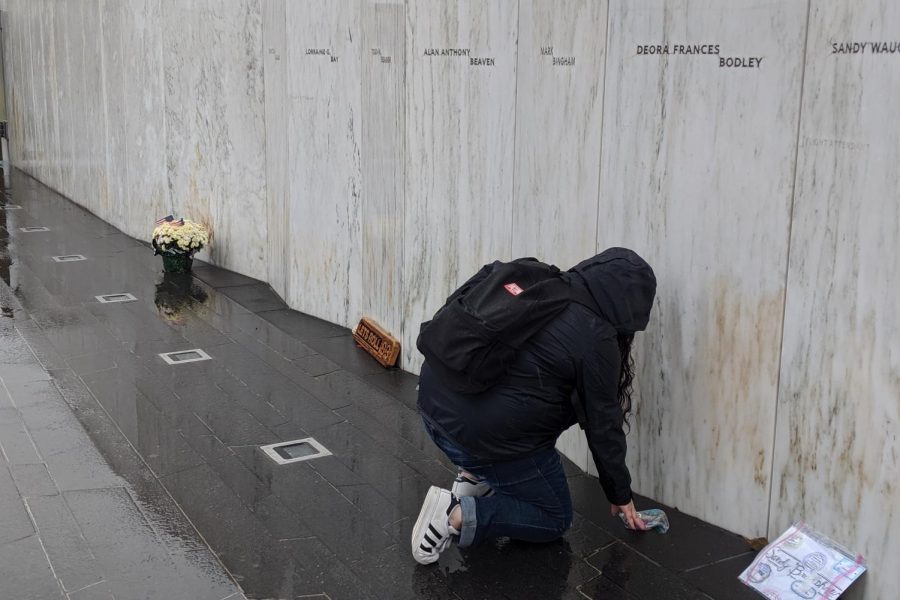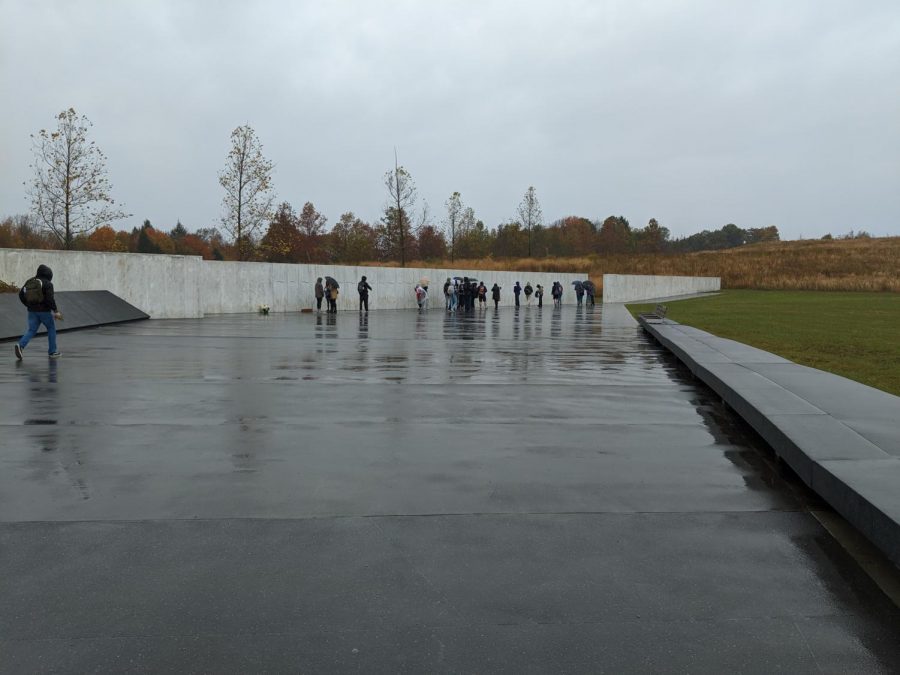Visiting the Flight 93 Memorial: Shanksville trip changed perspectives of 9/11
Senior Elizabeth Gilmore places the tribute she made at the Wall of Names.
November 11, 2019
Elizabeth Gilmore placed a painted rock at the base of the Wall of Names to honor Deora Bodley. On it was a drawing of the earth surrounded by a peace sign. When she researched Bodley’s life, Gilmore learned that Bodley often spoke of how she wanted to live in a more peaceful world.
This was just one of the activities that Darren Hornbeck, 9/11 to the Present instructor, assigned to his students to prepare them for the field trip to the Flight 93 Memorial.
Before the 9/11 to the Present class visited the site, they knew only information from websites and class discussion.
On October 16, just over a month after the nation’s remembrance of 9/11, Hornbeck took students to Pennsylvania to visit the crash site.
Anyone in high school today is too young to remember September 11, but the event is ingrained in American culture. No one can experience the same pain that people who lost loved ones have experienced for 18 years, so visiting these national monuments is vital to understanding the phrase they so often hear: “Never forget.”
“It’s easy to distance yourself from an event when you don’t know about it or didn’t live through it, but after visiting the memorial I felt a lot closer to the event,” said Gilmore.
Hornbeck has wanted to take students to the Flight 93 Memorial for several years.
On the bus ride to the memorial, students were loud and social, but once everyone got out into the rain and the serious mood of the surroundings, they were quiet and respectful. The thought of visiting a place where many lives were cut so short hit students hard. The rain and cold emphasized the somber mood.
Students walked down a short trail to the Wall of Names, where each passenger of Flight 93 has their name featured on a marble panel. At first glance, the wall appears to be one connected piece of architecture, but the panels are actually separated from each other. This visual illusion demonstrates that though the passengers were all strangers to each other, and from different places and backgrounds, they came together on the flight to thwart the terrorists.
The symbolism of each portion of the memorial was a topic of class discussions before the field trip.
In order to make a deeper connection to these passengers, Hornbeck had students and chaperones choose a passenger to research during the weeks leading up to the trip. Participants used that knowledge to create a tribute that they could place at the base of their passenger’s panel. They assembled letters, original artwork, sports memorabilia, and flowers.
After spending some time at the Wall of Names, students continued walking past the field where Flight 93 crashed. The exact site of the crash is marked with a large, 16-ton boulder. The designers of the memorial have placed a emphasis on natural markers and landmarks to commemorate sites like this one, allowing nature to figuratively heal the “wounds” in the land.
This symbolism continues even away from the actual crash site, at the memorial museum. Here, students could see a timeline of the events on the morning of September 11, tributes to victims, and artifacts recovered from the plane.
For many on the trip, one of the most emotional parts of the museum was an exhibit where they could listen to several phone calls made by Flight 93 passengers before the crash.
“It’s really moving to see how calm people stayed, but it was very sad as well,” said Gilmore. “There was one phone call where the woman was calling her sister and telling her where her safe was, with her money in it.”
The woman Elizabeth referred to is Linda Gronlund, who was travelling with her boyfriend, Joe DeLuca, on September 11.
The visit to the memorial definitely changed the perspectives that many students held before attending.
“The trip was very eye-opening,” said senior Ashley Ridgely. “[As someone who] doesn’t have any sort of personal connection to 9/11, actually visiting the site of the Flight 93 crash made me have much more respect for how tragic the event was. It has given me a whole different feeling toward that day.”
Not only did the field trip help students understand the feelings of Americans after 9/11 more deeply, it also emphasized the fact that despite the terror of the day, there were acts of good on 9/11 too. Many Americans believe that more acts of good came out of 9/11 than acts of evil. The number of people who risked, or even gave their lives to save others greatly outnumbers those who tried to take lives.
Because of how enriching this experience has proven to be for students, Hornbeck hopes to take future 9/11 to the Present classes to the Shanksville memorial as well. He is already considering a spring field trip for the two classes he will have next semester.
Hornbeck created the 9/11 to the Present course after thinking of the idea in 2015. He dedicated an entire summer to forming the curriculum through extensive research. His goal is to help students to better understand the horrific day in history and the ways that the single day altered the American experience even today.
“9/11 changed the world, but most [current students] were born into a world after those events transpired,” said Hornbeck.
Hornbeck often reminds his students of the difference between the world before and after 9/11.
If you are interested in taking 9/11 to the Present, make sure you register for it for the 2020-2021 school year.







